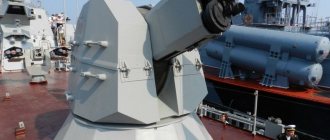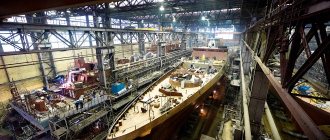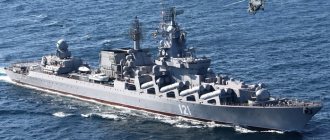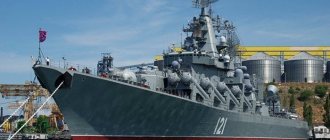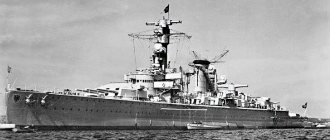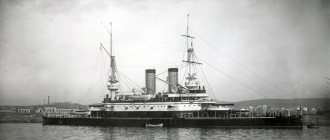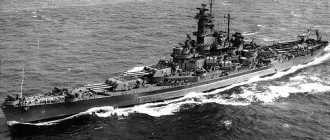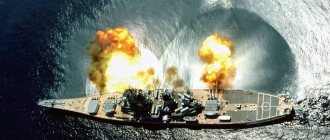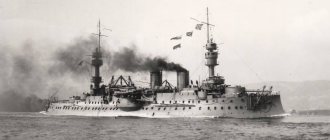For other ships with the same name, see Russian ship Imperator Nikolai I.
| Plan and side views | |
| Class Overview | |
| Name: | Emperor Nicholas I |
| Operators: | Imperial Russian Navy |
| Preceded by: | Empress Maria class |
| Successor: | Soviet Union class |
| Planned: | 1 |
| Canceled: | 1 |
| Story | |
| Russian empire | |
| Name: | Emperor Nicholas I |
| Namesake: | Nicholas I of Russia |
| Operator: | Imperial Russian Navy |
| Ordered: | September 12, 1914 [Note 1] |
| Builder: | ONZiV, Nikolaev |
| Expenses: | 45,080,000 rub. |
| Put: | April 28, 1915 |
| Launched: | October 18, 1916 |
| Renamed: | Demokratiia ( democracy ), 29 April 1917 |
| Fate: | Transferred to the Ukrainian Navy in 1918. |
| Ukraine | |
| Name: | Democracy |
| Namesake: | Democracy |
| Operator: | Ukrainian Navy |
| Renamed: | Cathedral Ukraine , January 25, 1919 |
| Fate: | Transferred to the USSR Navy in 1919. |
| Soviet Union | |
| Name: | Cathedral Ukraine |
| Namesake: | Union of Ukraine |
| Operator: | Soviet fleet |
| Renamed: | Democracy |
| Fate: | Decommissioned 28 June 1927 |
| General characteristics | |
| Type: | Battleship |
| Bias: |
|
| Length: | 182 m (597 ft 1 in) |
| Ray: | 29 m (95 ft 2 in) |
| Project: | 9 m (29 ft 6 in) |
| Installed power: |
|
| Movement: | 4 shafts, 4 steam turbine units |
| Speed: | 21 knots (39 km/h; 24 mph) |
| Addition: | 1,174 |
| Weapons: |
|
| Armor: |
|
Emperor Nicholas I
(Russian: Imperator Nikolai I:
Imperator Nikolai I
) was a Russian dreadnought built during World War I for service in the Black Sea.
She was designed to counter the numerous promising Ottoman dreadnoughts that were transferred by order of the Ottoman government, as this increased the likelihood that the Russian dreadnoughts being built for the Black Sea Fleet could be outclassed. The ship used the same main armament as the previous Empress Maria
, but was larger and better armored.
Emperor Nicholas I
was started in 1916, but construction was suspended on October 24, 1917. The Soviet Union considered completing construction in 1923, but later rejected the idea. In 1927, she was towed to Sevastopol and scrapped.
Design and development [edit]
Imperator Nikolai I
was developed in response to attempts by the Ottoman Empire to acquire modern dreadnoughts from abroad.
By the end of 1913, it appeared that the Turks would be able to assemble three dreadnoughts, two of which were armed with 13.5-inch (343 mm) guns, against the three Russian Empress Maria
-class dreadnoughts then under construction.
A modified version of the class would be the fastest to enter service, and preliminary design work began in December of that year, well before it was officially ordered on 12 September 1914. It was a much larger and more heavily armored ship than the previous one. ships, but her guns and equipment were virtually identical to the Empress Maria
to save time. [1]
General characteristics [edit]
Emperor Nicholas I
was significantly larger than the previous
Empress Maria
.
The ship had an overall length of 182 meters (597 ft 1 in), a beam of 29 meters (95 ft 2 in), and a draft of 9 meters (29 ft 6 in) when fully loaded. The ship displaces 27,830 metric tons (27,390 long tons) at standard load, 3,000 metric tons (3,000 long tons) more than the Empress Maria's displacement of 23,413 metric tons (23,043 long tons) and 31 877 metric tons (31,374 long tons). at full load. High-strength steel was used throughout the body, with low-carbon steel used only in areas that did not contribute to structural strength. The hull was divided into 20 transverse watertight bulkheads. The engine room was divided by two longitudinal bulkheads between frames 95–107, and a central bulkhead separated the condenser compartment. The double bottom was 1.2 m (3 ft 11 in) deep and she was given an icebreaking bow, probably in the hope that she would be able to operate beyond the Black Sea. Frahm anti-roll tanks were installed on each side to reduce its rolling. She had two electrically operated rudders on the centerline, the main rudder aft of the smaller secondary rudder. Imperator Nicholas I
" is designed with a metacentric height of 1.2 meters (3.9 ft). [2]
Propulsion system[edit]
Machines of Emperor Nicholas I
differed only slightly from the cars of their predecessors. The wing driveshafts were driven by the front and rear high-pressure turbines, and the inner shafts were driven by low-pressure turbines. A total of 29,700 hp were produced. (22,100 kW). 20 mixed-firing triangular Yarrow boilers are water-tube boilers feeding turbines with an operating pressure of 17.5 atm (257 psi). The forward group of eight boilers was located between the first and second towers, and the aft group of twelve boilers was located between the second and third towers. Top speed was rated at 21 knots (39 km/h; 24 mph). The maximum coal capacity was 3,557.3 tonnes (3,501 long tons), 1,500 tonnes (1,500 long tons) more than its predecessor's 2,000 tonnes (2,000 long tons), plus an unknown quantity of fuel oil. [3]
Emperor Nicholas I
had four main and two auxiliary Curtiss-AEG turbogenerators, each driving two dynamos, one each for alternating current and direct current. Each main generator was designed for 360 kilowatts, and auxiliary ones - 200 kilowatts each. They powered a complex electrical system that combined alternating current for most equipment with direct current for heavily loaded equipment such as turret motors. No diesel - there were generators. [4]
Weapons [edit]
Her main armament consisted of a dozen 12-inch Model 1907 52-caliber guns mounted in four triple turrets distributed along the length of the ship. These guns were identical to those used on the Empress Maria
, but the turrets were modified to increase the rate of fire. [5] The guns could be lowered to -5° and raised to 25°. They could be loaded at any angle from –5° to +15°; Their rate of fire was supposed to be three rounds per minute with an elevation angle of up to 15°. The towers could rise at a rate of 3–4° per second and rotate at a rate of 3.2° per second. 100 rounds per gun were fired at full load. The guns fired 470.9 kg (1,038 lb) projectiles with a muzzle velocity of .762 m/s (2,500 ft/s); this provided a maximum range of 23,230 meters (25,400 yd). [6]
Secondary armament consisted of twenty 130 mm (5.1 in) Model 1913 55 caliber guns mounted in casemates. They were arranged in two groups, six guns per side from the front turret to the rear funnel, and the remaining four grouped around the rear turret. The three guns on each side were positioned to fire forward, as this was the most likely direction of attack for the torpedo boats, as the naval general staff had assumed. [7] Their rate of fire varied from five to eight rounds per minute, and they carried 245 rounds per gun. They had a maximum range of about 15,364 meters (16,802 yd) with a 36.86 kg (81.3 lb) projectile at a muzzle velocity of 823 m/s (2,700 ft/s). [8]
The original anti-aircraft armament was to have consisted of four 38 caliber 2.5 in (64 mm) anti-aircraft guns mounted on the roofs of the fore and aft turrets, but these were replaced during construction by four 37 caliber 4 in (102 mm). mm) of a new design that never entered service. Four 17.7 in (450 mm) diameter underwater torpedo tubes were also installed, two on each side in the compartments between frames 43–46 and 113–15. Twelve torpedoes were carried behind them. [7]
Fire control[edit]
Initially, 6-meter rangefinders were planned to be installed in the conning tower, but during construction they were changed and were now installed in the front and rear main caliber turrets using periscopes in armored hoods on the roofs of the turrets. [7] They would provide data to the central gun station for the crew to use, and then transmit it to the guns so that the gun crew could follow them. [9] The new domestically produced Erikson mechanical computer was intended to be used. [7]
Defense[edit]
"Emperor Nicholas I"
had much heavier armor than
the Empress Maria
, as the armor weight for the former was 2,576 long tons (2,617 t) more than the older ships.
Even so, Russian armor factories were unable to roll Krupp cemented armor plates larger than 270 millimeters (10.6 in), which was compensated by increasing the thickness of the internal fragmentation bulkhead. The plates were sized to fit the frame to provide support for their joints, and they were joined together to better distribute the shock of projectile impact. The waterline belt had a total height of 5.2 meters (17 ft), of which 3.45 meters (11.3 ft) were above the design waterline and 1.75 meters (5 ft 9 in) below. Ahead, the remainder of the waterline was protected by two straits; the lower of which was originally 200 millimeters (7.9 in) thick but thinned to 100 millimeters (3.9 in). It extended 90 centimeters (35 in) above the design waterline. The upper belt was 100 mm thick and reached the middle deck. Aft, the waterline was 175 millimeters (6.9 in) thick and ended in a 175 mm transverse bulkhead aft of the steering gear. The aft section between the upper and middle decks was the only unarmored part of the hull and had a 300 mm (12 in) transverse bulkhead to protect the turret's rear magazine from shells fired from the rear bearings. The forward bulkhead was only 25 millimeters (0.98 in) to serve as a fragmentation bulkhead, as it was protected on all sides by side or deck armor. The 75 millimeter (3.0 in) top chord ran from the bow to the aft turret and was 2.95 meters (9 ft 8 in) high. For the first time it was made from cemented armor, saving 300 long tons (305 t) and 140 long tons (142 t) compared to the uncemented plates used on the Gangut and Empress Maria
respectively. Behind the side armor was a hardened face. An internal longitudinal fragmentation bulkhead was 75 mm thick between the middle and lower decks, but reduced to 25 mm between the middle and upper decks. At the same time, from the edge of the lower deck to the lower edge of the armored belt there was a slope 75 mm thick. [10]
The main battery turrets had a front and rear thickness of 300 mm, sides and roof - 200 mm. Barbettes were 300 mm thick, but were reduced to 225–250 mm (8.9–9.8 in) behind other armor. The conning tower sides were 400 millimeters (15.7 in) thick with a 250 mm roof. The funnel receivers were protected by 75 mm of armor, but reduced to 25 mm between the upper and middle decks. The upper deck was 35 millimeters (1.4 in) thick, which was intended to trigger the fuze of any shell penetrating it before it reached the main armored deck, which was 63 mm (2.5 in) thick above the armored citadel. In front of the citadel, the upper deck remained 35 mm thick, but at the stern the armored decks dropped to the level of the top of the waterline (35 mm deck), and the 63 mm deck was at the lower edge of the belt. Underwater protection was minimal, as there was only a 10-millimeter (0.39 in) watertight bulkhead behind the upward-projecting double bottom, and even this was squeezed out as the hull tapered towards the end turrets. [eleven]
Differences between the battleships "Empress Catherine II" and "Emperor Nicholas I"
Its original project also underwent changes at the request of the State Administration. In particular, the 75-mm side armor in the nose from 0 to 27 shp was abolished. above the middle deck, due to which the latter along the same length thickened from 6 to 35 mm, and the upper one, on the contrary, thinned from 35 to 12 mm (this lightened the bow by about 72 tons); the side belt along the waterline in the stern and the beam at 146 shp were strengthened. from 175 to 200 mm, and the stern overhang is between 131-149 sh. thickened from 13 to 25 mm. In general, these changes reduced the weight by 18.9 tons. Another 8 tons were gained thanks to the installation of armor plates with a long edge vertically proposed by ONZiV, which also turned out to be convenient when connecting them together with dowels, for which it was necessary to straighten the middle branches of the frame contours in the aft part .
Somewhat later (October 10, 1914), the technical council of the GUK made a decision, approved five days later by the Minister of the Navy, to change the method of armoring casemates on sections of the middle deck to that adopted somewhat earlier for armored cruisers of the Izmail type - instead of curved ones according to the design close to the upper edge the main (lower) belt of the upper slabs, make it horizontal by applying linings of the same thickness to 50 mm sections of the middle deck. In terms of penetration, such two-layer 100-mm armor should, in the opinion of the State Administration, be no worse than 75-mm inclined cemented armor, the quality of which was significantly reduced when bent. This decision was explained, first of all, by the enormous difficulties in making and installing such curved armor plates.
Further, as follows from the accompanying note, the project was characterized by the following points: the 7th casemate of 130-mm guns, in order to be able to install the heel of a boat crane in it, was moved forward by one space; the lines of the propeller shafts were changed in order to avoid the convergence of the outer to the inner, which was present in the development of the GUK; the bomb cellars of the 1st and 4th turret installations were located more rationally than on the Empress Catherine I, and the entire 130-mm ammunition was placed on the platform; To differentiate the ship, the ship's supplies were concentrated on the aft platform.
Externally, the project differed from ships of the Empress Maria type in that it had modified bow contours to reduce the bow wave that arose during the move, carried out at the suggestion of the head of the Shipbuilding Department of the State Administration, Lieutenant General P. F. Veshkurtsov.
A new theoretical drawing, in the development of which one of the future creators of the famous French liner Normandie, naval engineer V. I. Yurkevich, participated, unlike the one previously proposed by Major General I. G. Bubnov, not only reduced the bow wave (by about one and a half times) , but also contributed to a reduction in the power of the power plant by almost 2000 hp. while maintaining the project progress. All this found additional confirmation when testing ship models in an experimental pool in England, carried out on behalf of ONZiV. As a result, despite the displacement increasing by almost 4000 tons, it turned out to be possible to adopt for the ship the same power plant as on the Empress Catherine II (it was originally planned to speed up the construction of the battleship), that is, without an additional steam boiler, the need for which was associated with an increase in steam production to achieve the design speed in the initial theoretical drawing of the hull.
The shape of the stem was also different, modeled after the Sevastopol-class battleships. Moreover, in order to avoid excessive thickening of the stem for sticking a wooden lining under the armor to it, the lining was positioned so that it did not reach the stem itself, thinning to 25.4 mm on the last armor plate; the void that formed further was filled with a wedge seal made of steel sheet, as was the case on the “Empress Catherine II”. Along the way, this approach reduced the weight of the stem in the upper part and made it possible to cast it at the factory.
In the meantime, while the departments of the State Administration of Internal Affairs were studying the sent project, work was already underway on the open slipway of ONZiV to assemble the hull of the fourth Black Sea battleship, which had begun on June 9, 1914 (the construction supervisor was naval engineer Colonel A.L. Kossov). The official ceremony of laying down the battleship, in which Nicholas II took part, took place on April 15 of the following year. The order to enroll him in the lists under the name “Emperor Nicholas I” was signed much later - on July 2 of the same year.
Laying down of the battleship "Emperor Nicholas I"
This violation of the accepted sequence - first enrollment in the fleet lists, and then bookmarking - can perhaps only be explained by the following. The fact is that the determining factor for a ship to be included in the lists was the receipt of loans for its construction. The decision to build a fourth battleship for the Black Sea was approved by Nicholas II on March 23, 1914, and the additional program in accordance with which construction was carried out (in addition to the battleship, it included two more cruisers, eight destroyers and six submarines), approved by the Council of Ministers and the State Duma, the emperor signed only shortly before the war - on June 24.
Choosing a battleship name
It is quite natural, therefore, that with the outbreak of hostilities, the usual procedure was disrupted and the order for the construction of the battleship (in the factory documents of that period it was called “Ioann the Terrible”) was issued only on August 30. Under what name its construction began on June 9, 1914 is unknown, since the original foundation board, if it existed at all, has not been preserved. At the official ceremony, judging by the mortgage board stored in the TsVMM funds, the battleship was already called “Emperor Nicholas I”; however, the mentioned board could simply be a duplicate made later.
It should also be noted that the Moscow State School provided the emperor with two names for approval - “Holy Equal-to-the-Apostles Prince Vladimir” and “Emperor Nicholas I”, of which he chose the second.
The reviewed project received a generally positive assessment and, as ONZiV reported on November 14, 1914, after making the noted comments and corrections, it could be sent for final approval. In particular, the enterprise had to take into account the following: the displacement during inspection turned out to be equal (at a depth of 9 m) to 27,627 tons; the bow frames did not fall apart, and even turned out to be “sharper” than in the original design and on the battleship Empress Catherine II, where the upper 75-mm armor belt prevented this. Therefore, in view of the importance of the camber of the tank, it was necessary to take all measures to maximize it and, in any case, make it larger than on the prototype. Further, it was pointed out the desirability of increasing the capacity of the coal pits on the lower deck by installing longitudinal bulkheads of the electrical wire corridor (in the area of 48-62 and 70-86 sp.) parallel to the side bulkhead, and not the centerline plane. On the upper deck it was necessary to remove the bunk nets, strengthen the lining and fastening of the chimneys and, in general, all structures on the deck that fell within the range of action of the powder gases of the 305-mm guns.
In addition, the issue of installing tower rangefinders was considered, which would make it possible to divide the tower artillery into four autonomous groups with independent control, if necessary. A similar system was previously adopted during the development of the Izmail-class armored cruiser project.
The First World War of 1914-1918 interrupted the normal course of implementation of the shipbuilding programs adopted the day before and especially affected the construction of large artillery ships that were on the stocks.
Some orders had to be transferred from one overloaded enterprise to another with no less busy production capacity, and even new contracts had to be concluded. Thus, in July 1915, ONZiV had difficulty ordering parts from abroad for tower installations that were not manufactured in Russia (steel balls and ball bearings, seamless tanks for blowing, special chains, optical tubes), and in 1916 it signed a contract with the joint-stock company “L. M. Erickson and Co. for the supply of artillery fire control and central guidance devices.
Measures to improve seaworthiness
Meanwhile, complaints about the seaworthiness of the Baltic dreadnoughts became known, the contours of the bow of which became a model in the design of the Emperor Nicholas I; Moreover, the situation was aggravated by the trim on the bow that was revealed after construction. As a result, the ships' tanks were constantly subject to significant flooding, especially at high speeds and in fresh weather. The spray reached the wheelhouse and hit the sighting devices of the first turret, making it difficult to fire from it.
If at that moment practically nothing in the design of the bow ends could be changed on the already built Baltic battleships and those under construction on the Black Sea, then on the Imperator Nicholas I, which was on the slipway, they still decided to try something.
It was then that they remembered the events of three years ago, when, when drawing up technical specifications for the design of battleships of the Empress Maria type, the question was raised about the need to have an unarmored forecastle in order to improve their seaworthiness. However, then the head of the Moscow General Staff, Vice Admiral A. A. Ebergard (future commander of the Black Sea Fleet), recognized its installation as undesirable, citing an additional increase in both displacement and the affected surface, considering that the ship’s seaworthiness
“should be improved mainly by the surface contours of its bow, that is, by constructing a wide, cambered bow, which achieves better reflection of the water and, to some extent, increases buoyancy with the immersion of the bow.”
Project of the battleship "Emperor Nicholas I"
Battleship "Emperor Nicholas I"
For this purpose, A. A. Eberhard proposed to carry out appropriate experiments in the Experimental Pool with the aim of
“selection of the most advantageous surface bow formation.”
And now, at his own request and with the permission of the Minister of Naval Affairs, on September 21, 1915, the State Administration of Ukraine developed a “Project for the construction of a forecastle” for the battleship “Emperor Nicholas I.”
Drawing of the forecastle of the battleship "Emperor Nicholas I"
However, presenting it to the Minister of Maritime I.K. Grigorovich on October 9, 1915, P.F. Veshkurtsov could not help but point out the negative aspects if this project were implemented, namely: an overload of 450-500 tons, an increase in the average depth by 0 .15 m (9.14 instead of 8.99), bow trim by 0.84 m, decrease in stability (by 0.17 m or 11.3%) and speed (by 0.5 knots). Additional work on installing the forecastle, according to ONZiV, could cost about 750 thousand rubles. (including reworking the turret installation and installing additional armor on its fixed parts between the upper deck and the forecastle deck, as well as the conning tower between these decks), and also cause a delay in the ship's readiness by about a year.
This was considered unacceptable, and the result was summed up by the resolution of I.K. Grigorovich:
“The matter should be stopped. Notify admin. A. A. Eberhard, forwarding the paper in which he refused the forecastle.”
But having abandoned the construction of a forecastle, they nevertheless did not abandon attempts to improve seaworthiness, which ultimately resulted in the creation in 1916 of a project for installing an additional bulwark from the bow to the first tower installation (height at the stem 1.1 m, by 31 sp. - 0.8 m), which was approved for execution.
Project of an additional stem for the battleship "Emperor Nicholas I"
Drawing of the battleship "Emperor Nicholas I"
Construction[edit]
Emperor Nicholas I
construction stage
Construction began on June 22, 1914, by ONZiV in Nikolaev, after the launch of the Empress Catherine the Great on June 7 cleared a construction landslide. However, she was not actually laid down until April 28, 1915, with the intention of launching her in October 1915. The normal construction schedule continued until early 1915, as the Russians believed the war would soon end. However, workers were diverted to more important projects, and war production began to interfere with the delivery of materials that began shortly thereafter, delaying its launch until October 18, 1916. During construction, several proposals were considered to modify it in light of the problems demonstrated by the Empress Maria
- class in service.
They don't sand well on the nose and were very wet at the front. A proposal was made to equip the Imperator Nicholas I
with a forecastle deck to improve her seaworthiness.
This was rejected because the additional weight from the forecastle and the lift of the forward barbette actually worsened her forward trim. However, the proposal to add a 1.1-meter bulwark forward was accepted. Work on it continued at a slow pace during the February Revolution of 1917, but turbulent times disrupted its construction and further delayed it. It was renamed Democracy (Russian: Democracy: Democracy).
) on April 29, 1917, and is estimated to have been approximately 60% complete. Industrial unrest and strikes further slowed progress, and the provisional government postponed further work on 24 October 1917 until a "more favorable time". [12]
She was captured on 17 March 1918, when Nikolaev was occupied by the Germans and Austrians, but they did nothing with her incomplete hull. On January 25, 1919, she was listed by the Office of the Ukraine as scheduled for completion and placed on the Navy list by 1920. On January 27, 1919, it was mentioned in the order of the Office of the Naval Ministry in the list for renaming from 1920 - into Soborna Ukraine (Russian: Soborna Ukraina: Union of Ukraine
). [13] However, none of the Department's short-lived orders were actually implemented. [14] She remained in Nikolaev throughout the Russian Civil War, useless to either side. The victorious Soviets finally inspected it in 1923 to see if it was worth completing. Its dilapidated condition and outdated design led them to conclude that it was not worth making and that it should be sold for scrap. Attempts were made to sell the hull abroad to raise hard currency, but when this fizzled out, she was towed to Sevastopol on 28 June 1927 to begin dismantling. [15]
Nikolaev shipyards
In the early spring of 1914, the approved drawings of the warship with draft specifications went to Nikolaev. At that time, the Russian Shipbuilding Joint Stock Company was engaged in the construction of large civil and military ships. The technical documentation was accompanied by a cover letter in which the shipbuilders were asked to determine the time of construction of the ship and the total cost. After a series of approvals, Emperor Nicholas 1, a battleship, was valued at 32.8 thousand rubles, and three years were allotted for its construction. True, the battleship received its final name somewhat later.
In the process of reviewing the submitted drawings by naval engineer V.I. Yurkevich proposed some changes that reduced the bow wave and helped reduce the load on the machinery. Subsequently, Yurkevich emigrated to France, where he was directly involved in the design of the French airliner Moggaps Ne. Many components of this ship were developed by engineers of the Russian Admiralty.
Footnotes [edit]
- McLaughlin, pp. 255-57
- McLaughlin, pp. 257-59
- McLaughlin, pp. 229, 262-63
- McLaughlin, pp. 262-63
- McLaughlin, page 260
- "Russian 12" / 52 (30.5 cm) Sample 1907 305 mm / 52 (12 ") Sample 1907". January 10, 2010. Retrieved January 18, 2010.
- ^ abcd McLaughlin, page 261
- "Russian 130 mm/55 (5.1″) Plan 1913". May 10, 2006. Retrieved January 3, 2010.
- Friedman, Norman (2008). Naval Firepower: Battleship Guns and Artillery in the Dreadnought Age
. Annapolis, MD: Naval Institute Press. pp. 273–75. ISBN 978-1-59114-555-4. - McLaughlin, pp. 261-62
- McLaughlin, page 262
- McLaughlin, pp. 258-59
- ↑
Svyatoslav, Shramchenko (1932).
“The law about the sovereign fleet is the same.” Pour la souveraineté. Materials concerning the history of the Ukrainian army
.
2.pp.131–133
_ - Ukrainian state creation: undemanding potential: Dictionary-editor / Ed. O. M. Mironenka. - K., Libid, 1997 ISBN 5-325-00767-X pp. 205–206.
- Jump up
↑ McLaughlin, pp. 258, 331
